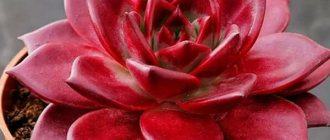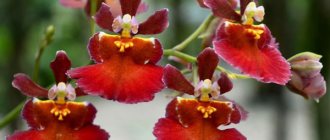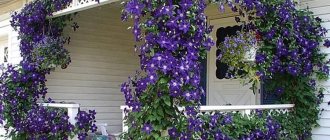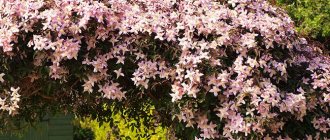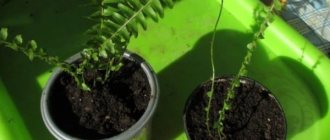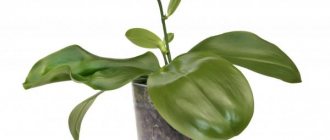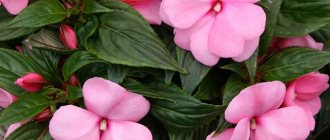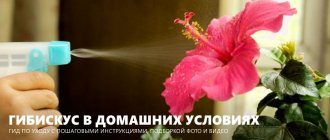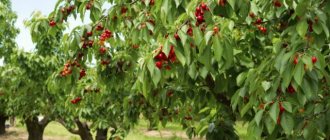There are up to 650 species of fern in the world, but only a few are used in indoor floriculture. With proper care, the plant can grow for up to 10 years. Asplenium is valued only for its beautiful leaves; this fern never blooms. It is often used to decorate offices, administrative premises and institutions.
| Average growth rate. |
| Asplenium does not bloom. |
| The plant is easy to grow. |
| Perennial. From 4 to 10 years. |
Botanical description of asplenium
Asplenium is a perennial herbaceous plant belonging to the Kostentsov family. Asplenium is popularly called ossicle. It is a low spreading perennial plant with large leaves that lean in different directions. An indoor fern, in hot climates it can grow in open ground. The height of the bush does not exceed 50 cm. Wild shrubs are relatives of indoor asplenium and are larger in size. The length of the foliage of asplenium growing in the wild reaches 2 meters.
The crop has a poorly developed creeping or short rhizome located under the top layer of soil. In the natural environment, the rhizome of the kostenza is larger and more developed, going deep into the ground. Thus, the shrubs receive a sufficient amount of nutrients necessary for development.
Several spreading large leaves, collected in rosettes, extend from the base of the rhizome. The leaf blade is elongated, forked or pinnate. There are varieties with pinnate leaves dissected at the top. The leaf blade is bright green in color, even and smooth to the touch. The upper part of the leaf has a glossy tint, so the bushes shimmer in the sunlight. On the lower part of the leaf blade there are sporangia necessary for the propagation of the shrub. The leaves have small petioles that go into the ground. A network of veins is visible on the surface of the leaf plate.
Asplenium, due to its diversity of species, can take different forms and types of shrubs. The variety of shapes of the leaf plate and the size of the bush attract gardeners and landscape designers. Most types of asplenium have leaves with smooth edges, but in nature there are varieties with cut or torn edges, as well as jagged or sword-shaped.
Medicinal properties
The vast majority of types of kostenza have a purely decorative function, looking great in bouquets. Only certain varieties are used by healers to heal wounds or stop an attack of fever. They can also relieve an attack of pain, tone the body, and help with scurvy or jaundice. Indoor specimens are not endowed with such properties, so do not even try to use them for treatment.
Spreading
The southern regions of Africa are considered the natural habitat of the kostenza. In addition, different types of ferns can be found in different regions of the globe. Thus, in its natural environment, asplenium lives in the tropical climate of eastern Africa, Australia and New Zealand. You can also find wild shrubs in the northern part of India.
In temperate climates, asplenium grows as an indoor herbaceous plant. Since the perennial is not highly resistant to frost, asplenium is not grown in open ground. To grow asplenium in the wild, it is necessary to select hybrid varieties that can withstand the climatic conditions of the temperate zone.
Asplenium is unpretentious to the growing location and soil. Wild bushes grow on rocky or loose soil, rich in moisture and nutrients. At home, the plant grows actively in pots. An important condition for shrubs is constant air humidity and a hot climate, which allows greenery to grow in different directions.
Lighting
Asplenium does not need bright sunlight, the fronds will turn brown and die, and there will be no fountain in the interior. It will feel good in partial shade, but there should be enough light.
Windows in the north, west or east direction are ideal; even the corners of the room can be decorated with them. If the asplenium is on the south side, be sure to cover the sun with tulle or paper.
Asplenium also does not tolerate dense shade.
Asplenium bulbiferous.
Popular types of indoor asplenium
The genus Asplenium has approximately 700 species of different ferns. Shrubs differ not only in shape, but also in size. In addition, there are hybrid varieties that grow in any conditions. In Russia you can find about a dozen species of Kostenets.
South Asian asplenium asplenium australasicum
Eastern representative of ferns. Wild shrubs native to Australia. In the natural environment, asplenium of this species reaches one and a half meters in height. The width of the leaves of this species does not exceed 20 cm. The foliage cuttings form a dense rosette at the base of the bush, forming a funnel.
The rhizomes of the ossicle are straight, going deep into the soil. The roots grow strongly in different directions, thus keeping the plant erect. The roots are dense and wide. The surface of the roots is covered with scales, from which adventitious roots of various shapes appear. Small roots are tangled together and form a dense network above the surface of the earth.
The leaves of the variety are entire, with smooth or serrated edges. The leaf blade has a rounded shape, reaching its maximum width in the middle of the plate. The end of the sheet is pointed or rounded. Linear spores are located at the bottom of the leaves. The spores are located mainly along the central vein.
Asplenium nesting asplenium nidus
The variety is an indoor variety of Kostenza. In its natural environment, the crop grows in the humid tropics, so for development in indoor conditions it is necessary to maximally adjust the climate suitable for the shrub. You can even find such a plant in the tropics growing on the stems and trunks of some trees.
The plant has a large, well-developed rhizome that goes deep into the substrate. Thus, the fern receives a sufficient amount of nutrients necessary for the active growth and development of the bush. At the base of the rhizome is a dense, often tangled rosette of leaf petioles. The rosette is entangled by adventitious roots, forming a kind of nest.
Asplenium leaves are petiolate, solid rounded in shape. The edges of the foliage are smooth, the end is pointed. The leaf blade is light green, closer to a light green shade. In the middle of the leaf blade you can see a brown central vein, on the underside of which sporangia are located. When grown indoors, nesting asplenium is small in size, creating a pleasant appearance.
Asplenium scolopendrium
The characteristics of this species are similar to the previous type of asplenium. The peculiarity lies in the growing conditions. The natural habitat of the culture is considered to be Germany and England, where shrubs grow in deciduous forests. Only asplenium hybrids are grown under artificial conditions.
You may be interested in: Clitoria
The rhizome of the fern is thick and creeping. Most of the central roots and adventitious roots are located above the surface of the ground, entangled with a rosette of leaves. Erect leaves extend from the base of the roots, shaped like a belt.
The leaf plate has wavy edges, so the bush looks quite decorative. The leaves are light green in color, with smooth edges and a smooth end. In the center of the leaf plate there is a central vein, externally dividing the leaf into two parts.
Asplenium bulbiferum
A representative of deciduous asplenium, growing wild in Australia and India. Asplenium is small in size. The length of the leaf plate usually does not exceed 50 cm. At the same time, the leaves are quite wide - up to 20 cm. The fern is painted in light green tones. The peculiarity of the bush is the presence of fairly long petioles on the foliage, which can exceed 30 cm.
The leaves of the variety are smooth and round in shape. The upper part of the sheet plate has a glossy tint. The lower part of the leaves is a lighter shade. From below, the leaf blade has sporangia, which are located along the veins, on both sides of the plate. In addition, this species has brood buds that grow on the tips of the foliage. The leaves, forming a rosette at the base, bend their ends in the opposite direction, hanging down to the ground.
The culture is considered quite frost-resistant, so it can grow in temperate climates. Asplenium grows as a houseplant; it is planted in greenhouses, along the edges of alpine hills.
Asplenium viviparum asplenium viviparum
Heat-loving representative of Kostenets. The plant is native to the southern regions of Madagascar. A perennial species that grows in fertile soil with plenty of minerals. The shrub is evergreen and forms a basal rosette for several years.
The culture has a creeping rhizome growing in different directions. From the base of the central root, adventitious branches emerge, which become entangled and form a dense fabric near the ground. From the base of the rhizome a rosette of leaf petioles is formed.
The leaves of Asplenium viviparous are located on short petioles. Unlike many varieties, the leaf blade is not solid, but is divided into two or more lobes. The shrub is quite small in size, the length of the leaves does not exceed 60 cm, the width in the center is about 15 cm. The length of the leaves and their thinness do not allow the foliage to support its weight, therefore, as it grows, the leaf plates bend to the ground, forming an arc.
On the surface of the inner part of the leaf you can see sporangia, which are located on both lobes of the leaf blade. After sporangia fall into the ground, they quickly take root and germinate. In addition, along the edges of the leaves there are brood buds, which also easily germinate and form a new shrub.
Carrot leaf asplenium daucifolium
It is a perennial native to Madagascar. The plant lives in a tropical humid climate. Hybrids take root well in greenhouses and alpine hills. The shrub is small in size. The height of the crop living in the wild does not exceed a meter, and the height of domestic varieties reaches 50 cm.
The variety is represented by leaves with short petioles, forming a dense rosette at the base. The leaves are segmented and form a dense nest inside the bush. The abundance of segments makes the species similar to ordinary ferns growing in temperate climates. Each segment is represented by small sword-shaped leaves. The segment length reaches 3 cm and width up to 5 mm. The segments are attached to the main central core of the sheet.
The outer surface of the foliage is painted in dark green tones. While the lower part of the foliage has a lighter base. The brood buds are located on the upper part, and sporangia are located on the lower part. Sorus are located along the edges of the segmental part of the leaf.
Asplenium hairy asplenium trichomanes
The bone of this type has a peculiar smell. The peculiarity of the plant is the ability to take on different leaf shapes. It is a small shrub, the height of which does not exceed 50 cm. The rhizome of the plant is short, covered with small black scales.
The crop has evergreen foliage. The leaves are divided into many segments. The base of the leaves forms a brown rosette. This is due to the fact that the central part of the leaf plate is colored brown. The surface of the petioles and the central part of the leaf is glossy. Each segment is sessile and round in shape. There are varieties with dissected or smooth edges of the segments.
Unlike its relatives, culture has an economic purpose. The beneficial properties of the chemical composition of the plant allow it to be used as a remedy for hair loss. The plant is also used to create decorations. In folk medicine, the culture is used in India as an anti-bronchitis remedy, a laxative and a diuretic.
Asplenium crispy wave
An unpretentious small shrub. Used as indoor culture. The ossicle of this species is quite resistant to frost, so it can grow in open ground. However, to prevent freezing, the crop is covered with insulation for the winter. In addition, the culture can often be found indoors.
The leaves of the shrub have a rich green color. The leaf plate is wavy in shape, similar to corrugated paper. The leaves are soft to the touch, with smooth edges and a visible central vein. The upper part of the leaf plate is glossy. Sporangia are located on the lower part of the leaf.
Asplenium nidus
The plant is represented by a variety of nest-shaped stones. Under natural conditions, the shrub grows on trees and rocky surfaces. The culture has good decorative qualities, since the appearance of the plant has rounded, even outlines. The shrub is quite fragile, the leaves are delicate and break quickly.
Asplenium is small in size. The height of the bush does not exceed 60 cm, so the crop is often planted in indoor pots. In temperate climates, the crop is quite rare, since the fern needs a large amount of light all year round for active growth.
You may be interested in: Bougainvillea
The leaves are entire, petiolate, light green in color. In some places you can see shades of purple on the leaves, which makes the shrub more decorative. The central vein of the leaves is also purple. The leaves are erect and grow vertically upward, so the bush has an even shape.
Asplenium osaka
The peculiarity of the variety is its fastidiousness. The culture does not tolerate moisture getting inside the root rosette. If water stays inside the foliage for a long time, the fronds quickly die off. The shrub is represented by fairly large leaves, up to a meter long.
The leaves are rich green in color, with smooth edges, wavy in places. The central part of the leaf blade is brown or burgundy. leaf shape is pinnate. The leaves are located on short petioles and bend towards the ground as they grow.
Care
Asplenium ferns are actively grown indoors. However, to create and maintain a decorative type of crop, several important rules for caring for shrubs are necessary. For ferns, it is important to create habitat conditions that are as close to natural as possible.
Features of care after purchase
Immediately after purchasing a fern, the plant must be transplanted into a new pot. This is necessary to create more comfortable conditions for the plant. An important rule for replanting is to preserve the earthen clod, so the crop is transferred from one pot to another.
As a substrate, you should mix leaf soil, humus, pine bark and coconut soil. When replanting, it is necessary to create an optimal drainage layer at the bottom of the pot in the new pot. Thus, moisture will not stagnate in the soil, and rotting of the rhizome is prevented.
Lighting
For the kostenza, it is important that the foliage be constantly exposed to scattered sunlight. Direct rays leave burns on the fern, so the crop prefers to live in shaded places. In indoor conditions, the optimal place for planting ferns is the eastern or western part of the room.
Temperature
To grow a crop in a home environment, it is important to create temperature conditions that are comfortable for the bush. So, the bone feels normal at temperatures up to 27 degrees above zero. Frost-resistant varieties can grow actively at temperatures up to 10 degrees below zero. When grown indoors, in winter the air temperature is reduced to 15-18 degrees so that the fern can rest before the new season.
Humidity
Wild shrubs live in places of high air humidity. Therefore, when growing indoors, it is necessary to provide the crop with increased air humidity. In room conditions, you can create the necessary humidity by placing a container of water next to the plant. Also, the air around the bush is regularly sprayed with a spray bottle.
Do not place the pot next to heating devices. Dry air contributes to the rapid death of shrub foliage. If dry leaves are found on the plant, you need to move the pot to another place.
Watering
For ferns, it is important to choose the optimal watering regime, since the amount of water is considered an important component of the normal growth and development of the bush. Asplenium is a moisture-loving plant, but does not tolerate stagnation of water in the roots. Therefore, it is important to create a normal drainage layer at the bottom of the pot, which will prevent the development of rotting.
The substrate in which the fern is grown must be constantly moist. However, you cannot create dampness inside the soil. Therefore, when growing asplenium indoors, pour a generous amount of water into a tray under the pot. This way the roots absorb the required amount of moisture.
In winter, the frequency of watering asplenium is reduced to 1-2 times a week. However, the volume of water increases significantly. Thus, the plant does not dry out and rests peacefully from active growth.
Top dressing
Asplenium needs regular fertilization with diluted fertilizers. When choosing fertilizer, preference is given to fertilizers for indoor plants that contain the optimal amount of minerals and nitrogen. It is important to understand that fern does not require a large amount of elements for growth, so the dosage indicated on the package is halved.
Fertilizing is carried out twice a year - in spring, after the onset of constant warmth, and in autumn, with the onset of frost. Feeding the shrub should be done very carefully, pouring fertilizer into the pan along with the settled water.
The soil
Ferns need a nutritious and light substrate in which the plant's roots can breathe. Therefore, experienced gardeners create a mixture from soil. The optimal substrate for growing asplenium is considered to be a mixture of equal parts of turf soil, leaf soil, coconut substrate and humus. There should be a high-quality drainage layer at the bottom of the pot.
Pot
It is necessary to carefully approach the choice of a pot for bones. Adequate space for rhizomes is important for the plant. However, in large pots, the crop does not pick up greens well. Tall and narrow pots are considered optimal, in which the roots will be located in a small volume of substrate.
Transfer
Aspleniums do not require frequent transplantation. the plant is placed in new pots no more often than once every two years. Young individuals are transplanted immediately after purchasing the crop and as the pot is filled with roots.
Transplantation is carried out by transferring the plant from one pot to another. When replanting, it is necessary to preserve the maximum amount of soil on the roots of the plant. In addition, it is important not to touch or break the adventitious roots of the crop. After transplantation, the crop is watered abundantly.
When it blooms
Asplenium is not a flowering plant. The decorative purpose of the plant is due to the abundant foliage and neat forms of the bush.
Trimming
Asplenium pruning is carried out only when necessary. In spring and autumn, sanitary pruning of dry foliage of the crop is carried out. The bone has neat dimensions, so there is no need to shape the culture.
You may be interested in: Cyclamen
Spraying
Spraying is an important component for creating air humidity. However, it is worth understanding that moisture should not enter and remain in the outlet, since many varieties do not tolerate stagnation of moisture in the plant. Therefore, spraying is carried out carefully, trying not to spray water over the bush itself.
Possible problems
When caring for asplenium, some problems may arise associated with improper care of the shrub. So, when the crop is exposed to direct sunlight, burns quickly form on the foliage. At the same time, the leaves become spotted yellow. If the problem is not corrected in time, the foliage withers and the bush dies.
Ferns do not tolerate stagnation of moisture in the soil. The first signs of rot on the roots are wilting of the foliage and a faded appearance of the plant. If the plant is severely affected by root rot, the plant cannot be saved. If the asplenium has just begun to rot in constantly damp soil, it is worth transplanting the shrub to a new place with a large amount of drainage layer.
When air humidity is low, the tips of the leaves begin to dry out. After eliminating the problem and normalizing conditions, you will notice that the plant is gaining growth quite quickly. At low air temperatures, asplenium leaves curl.
Wintering
Asplenium is a heat-loving plant, so for growing in temperate climates, care must be taken to keep the shrub warm even in winter. In addition, it is necessary to prepare the bone for wintering.
In the fall, the number of waterings of the crop is gradually reduced, while maintaining the amount of water poured into the pan. The plant is gradually shaded and the amount of moisture in the air is reduced. For winter crops, the relative air humidity should be within 50%.
Asplenium is kept at a temperature of 15-18 degrees in winter. At the same time, culture slows down growth and development. The formation of sporangia on the foliage disappears. With the onset of warmth, the bone returns to active growth and development.
Reproduction of asplenium
If necessary, indoor varieties of asplenium can be propagated in three ways. Most often, brood buds are used for propagation of ossicles. Reproduction through spores and rhizome division is also important. Each division method differs in the speed at which new plants appear and the characteristics of caring for the sprouts.
Brood buds
Wild varieties of asplenium often reproduce using brood buds. They form on the top of the leaves. After falling to the ground, the buds quickly take root, giving rise to new crops.
To propagate asplenium using brood buds, you need to bury a piece of the leaf on which the bud is located in the ground. After planting, the crop is taken care of as usual, no different from an adult plant. After rooting, the sprouts can be transplanted to a permanent habitat.
Rhizome division
It is worth dividing the asplenium rhizome only when a large number of divisions have appeared on the adult individual. Having examined the root during transplantation, it is necessary to note the most convenient growth points in terms of location. During transplantation in the spring, these parts of the plant are separated from the mother and transplanted to a permanent habitat. As a rule, cuttings quickly gain growth and take root. It is important to understand that young plants cannot withstand low temperatures and drafts. Therefore, after planting, the crop is provided with warmth and good lighting.
Dividing the rhizome is painful for the plant, so when cutting the roots, the pruning area is treated with charcoal or a root growth agent. After planting, the plant first grows rhizomes and then produces foliage. Therefore, when propagating by dividing the rhizome, there is no need to choose a large pot right away; it is better to replant the plant after a year.
Controversy
Asplenium can be propagated using spores formed on the lower part of the leaf. The procedure is carried out in the spring, after the first spores appear. The optimal temperature for planting sporangia is considered to be room temperature.
To sow sporangia, the fern leaf is carefully trimmed, and the spores from it are scraped onto paper. You can try to remove the spores without cutting the leaf. Sowing of spores is carried out in disinfected soil that has undergone heat treatment in the oven. After abundant watering of the soil, the spores are evenly distributed on the soil surface. After sowing, for better germination, the spores are covered with glass or film to form condensation. The resulting container is placed in a dark, warm place until new shoots appear.
After the sprouts appear, the glass is removed. On average, spores sprout approximately 12 weeks after planting. After the seedlings appear, the container is transferred to a warm, illuminated place. Provide regular spraying of the crop. Grown crops can be planted in a permanent place.
How to propagate kostenets
Asplenium has three types of reproduction: rhizome division, adventitious buds and spores.
Bush division
In this way, it is possible to propagate overgrown asplenium in the spring, when the plant is replanted. The fern should be carefully divided with your own hands, and also pay attention to the number of growth points. If there is only one such point or there are few of them, the asplenium should not be divided, because of this it may die. After division, young specimens of the ossicle do not grow immediately.
Accessory buds
In viviparous forms of fern, the veins have special tubercles on which adventitious buds appear. From this bud a plant with dissected leaves and a short petiole can be formed. When they fall off, they begin an independent life. You can break off the accessory points along with the leaves and root them in loose soil. You can take those young individuals that have themselves taken root in the ground.
Diseases and pests of asplenium
Most often, the plant is affected by pathologies such as gray rot and leaf bacteriosis. These pathologies are associated with improper plant care. In this case, dry, limp foliage appears. To eliminate the problem, reduce fern watering and normalize the volume of infused water.
Also, foliage is often affected by diseases such as phyllosticta and taffina. The plant quickly withers and dies. Timely treatments with fungicides help correct the situation. In addition, the appearance of spots on the plant may be associated with nematode damage. In this case, it is almost impossible to save the plant.
Application
The plant is widely used to decorate rooms. You can meet asplenium in greenhouses and on alpine slides. Since it is quite difficult to grow kostenets, the plant is rarely used for growing in open ground. However, in the room the plant combines well with other plants, including succulents and flowering shrubs.
Some varieties of asplenium are used in folk medicine. In India, fern juice is used as a bronchodilator. Also, the chemical composition of the plant allows it to be used as a strong diuretic and a cure for diarrhea.
Folk signs
It has been noted that asplenium calms household members, so nervous people should definitely acquire such a flower. It will also balance spouses who have opposite characters and help them reconcile with each other.
They say that fern can bring good luck and prosperity to the house. It will also perfectly combat the attacks of evil spirits on your family.
But since the ossicle draws too much energy from the surrounding space, it is recommended to place it near a TV or computer. Let him eat to his heart's content! But it’s still better not to bring it into the bedroom. And people with allergies should not bring asplenium into the house, since during sporulation such people may have an attack.
